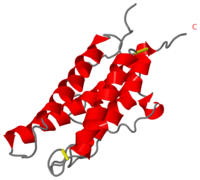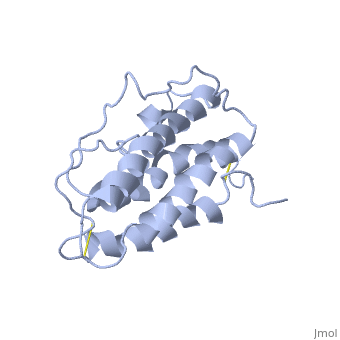User:Gourinchas Geoffrey/Sandbox 205
From Proteopedia
(Difference between revisions)
| Line 24: | Line 24: | ||
αA et αD are held together by a disulfide bond between <scene name='User:Gourinchas_Geoffrey/Sandbox_205/Cysteine_7/2'>Cysteine 7</scene> and <scene name='User:Gourinchas_Geoffrey/Sandbox_205/Cysteine_161/1'>Cysteine 161</scene>. | αA et αD are held together by a disulfide bond between <scene name='User:Gourinchas_Geoffrey/Sandbox_205/Cysteine_7/2'>Cysteine 7</scene> and <scene name='User:Gourinchas_Geoffrey/Sandbox_205/Cysteine_161/1'>Cysteine 161</scene>. | ||
| - | αB et αC are held together by a short loop. </StructureSection> | + | αB et αC are held together by a short loop. |
| + | |||
| + | The molecule of Erythropoietin have two opposite binding sites with his receptor. The first site include segments of αA, αB and αD and a part of the loop which connects αA and αB. This site include a hydrophobic center which interact with the receptor. | ||
| + | The Phenylalanine 93 of the receptor is critical important for binding of Erythropoietin to his receptor thanks to hydrogen bonds with residues Threonine 44 and Asparagine 147 of Erythropoietin. </StructureSection> | ||
Revision as of 21:23, 27 November 2011
HUMAN ERYTHROPOIETIN
|
Erythropoietin is a glycoprotein hormone which is involved in Erythropoiesis, which is the red blood cells production. It allows the differenciation of the erythrocyte precursors in the bone marrow.
Structure
| |||||||||||


